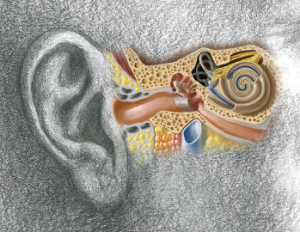
© Spencer Sutton / Science Source
If the ancient Greek Alcmaeon of Croton could only see the Eustachian tube now.
Explore This Issue
June 2018The man said to have discovered the tube around 450 BC would likely be amazed at the work that now goes into discerning patulous versus dilatory dysfunction. In fact, our growing understanding of the cartilaginous portion of the Eustachian tube interests many otolaryngologists.
Hence, this year’s otology/neurotology panel, “Is the Eustachian Tube the Key?” Unlike panel discussions in which each participant made a presentation, these four panelists participated in more of a round-table discussion.
Aural Fullness Roadmap
Otolaryngologist Sujana Chandrasekhar, MD, has had as many patients complaining of aural fullness as any other physician in the field. But is it dilatory Eustachian tube dysfunction (ETD)? Patulous ETD? Or something altogether different, such as superior canal dehiscence?
“All of us have seen patients referred in for Eustachian tuboplasty or dilatation because, based on symptoms, they’re thought to have dilatory dysfunction,” said Dr. Chandrasekhar, a past president of the American Academy of Otolaryngology–Head and Neck Surgery and a member of ENTtoday’s Editorial Advisory Board. “And I know that anecdotally we’ve all told each other that some of those patients have patulous ET dysfunction … or other things that cause a feeling of fullness in your ear.
But, despite the challenges, the roadmap to making the right differential diagnosis for aural fullness has guideposts, said Dr. Chandrasekhar. “If (a patient’s tympanic membrane) is retracted, then you’re looking for negative pressure, you’re looking for an effusion, maybe a flat or negative pressure tympanogram,” she added. “A myringotomy or a myringotomy with a tube insertion relieves symptoms. I’ll tell you, if I’m thinking about this, I’ll actually do office myringotomy and see if that works rather than just go ahead and do a full myringotomy with tube insertion.”
Dr. Chandrasekhar urged physicians to pay close attention to their endoscopies and “not just blow by the nasopharynx, but stop and turn and look as far into the lumen of the Eustachian tube as possible to see if the patient is having a dilatory dysfunction or not.”
Patients presenting with a normal tympanic membrane go down a road of questions that more often lead to patulous ETD, Dr. Chandrasekhar said. For example, she said she has patients who only have pressure equalization issues intermittently.
“I practice in New York City,” she said. “Some of my patients who live or work on very high floors have to actually pause their elevator and get off, [and then] equalize and finish coming back down.”